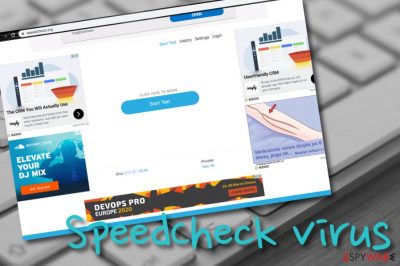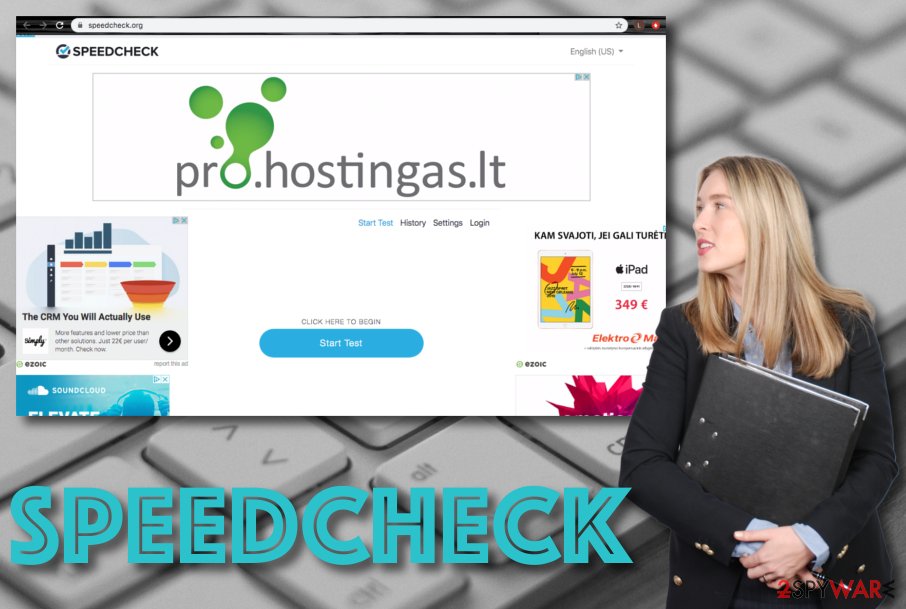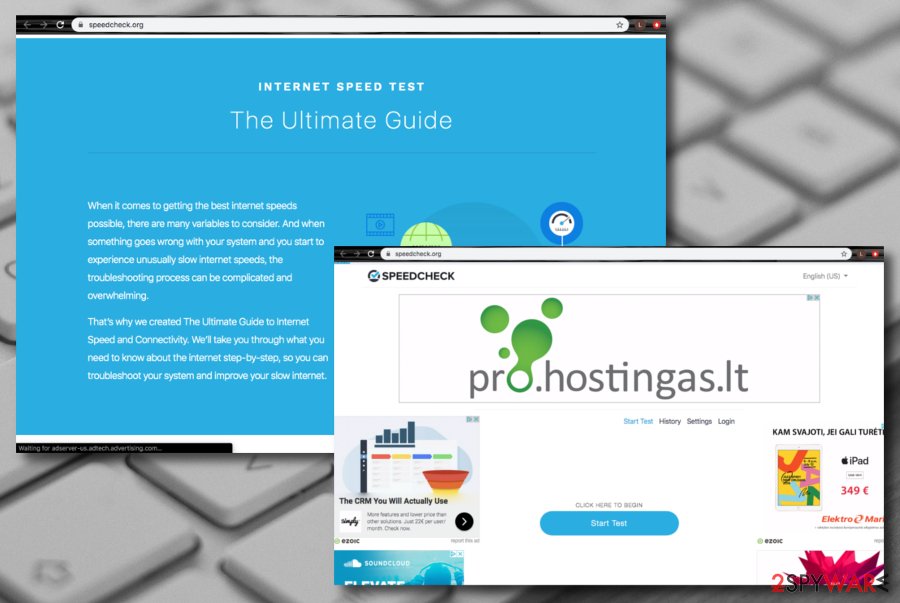Ads by Internet Speed Check (Free Instructions)
Internet Speed Check ads Removal Guide
What is Ads by Internet Speed Check?
What is Internet Speed Check?

There are a lot of free programs on the Internet that offer to check users' download and uploads speed, compare results to other types of connections and other similar-type services that later allow improving user's browsing performance. Internet Speed Check also belongs to this group of programs.
However, it also belongs to other categories, such as adware and potentially unwanted programs (PUPs) and that's why you should think twice before installing it. It was found that it mainly spreads with popular download managers and usually gets inside unnoticed.
| name | Ads by Internet Speed Check |
|---|---|
| Type | PUP, adware |
| Risks | Privacy issues, installation of shady tools, malware infections |
| Distribution | Fake Flash Player updates, software bundles, deceptive ads |
| Elimination | Use reliable security software to remove all cyber parasites hiding on your device |
| System health | By using the FortectIntego tool you will get your device back on its feet and avoid abnormal behavior, such as severe lag, crashing, etc. |
No matter how it gets inside, we do not recommend keeping it on your computer because it may track you, increase the vulnerability of your computer's security, slow down the system, cause redirects to questionable websites, and so on. In the worst-case scenario, this application may cause virus infection or even identity theft.
Once inside, it modifies various settings, drops its extension on Google Chrome, Mozilla Firefox, and Internet Explorer web browsers, and starts to deliver advertisements on each of them. We believe that it's difficult to browser normally with this adware inside the computer because it may display up to 20 ads on one web page.
Remember that it's not recommended to click on them because they may include links no only to affiliate websites, but also to the ones that are not associated with the publisher in any way and are filled with doubtful content. By the way, it can also slow down your computer and increase security vulnerabilities on your PC, so if Internet Speed Check redirects would make you visit unsafe websites, the chances that you install another adware or even malicious programs are high.
Therefore, you have to prevent such happening in advance by removing this intruder with reputable anti-spyware, for example, Malwarebytes or SpyHunter 5Combo Cleaner. When that's done, you should take care of the overall device's health by running system diagnostics with the FortectIntego system tune-up software.

How the PUP ended up on my device?
Internet Speed Check is sometimes confused with SpeedChecker because both programs are very similar. Be aware that these are two different programs no matter that they have a lot of common features. Therefore, you can be tricked into installing both of them as 'optional tools' alongside other free software.
In most cases, adware travel as a constituent part of bundled installers. Therefore, if you are not attentive enough when installing freeware, such as download managers, then you can easily end up installing your preferred download manager with Auto Cinema, ClickForSale, and much other adware alongside. In order to avoid this, you have to deselect all aforementioned programs during the installation of free software.
Avoid Quick or Basic installation option because it may not disclose additional components and install them automatically. Instead of it, select Advanced or Custom installation and look for various toolbars, extensions, add-ons, plug-ins that seem not familiar to you and, usually, are promoted in a vague way.
Check every notification that it set by default before clicking the 'I agree' button because you may accidentally accept installing potentially unwanted programs. In case it has already happened to you, don't worry. Such and similar programs are NOT viruses, so can be quite easily removed.

How to remove Internet Speed Check virus?
Internet Speed Check poses harm to your computer's security and, in reality, it's an absolutely useless app. You can remove it automatically or manually. For the former option, download one of our recommended security tools and perform a full system scan.
If you're willing to get your hands dirty, you can remove the adware manually. You can follow the guidelines that are below and make sure that you remove it as soon as possible. And in the future, stay away from software bundles and scan your device with proper AV tools at least twice a week.
You may remove virus damage with a help of FortectIntego. SpyHunter 5Combo Cleaner and Malwarebytes are recommended to detect potentially unwanted programs and viruses with all their files and registry entries that are related to them.
Getting rid of Internet Speed Check ads. Follow these steps
Uninstall from Windows
To eliminate suspicious applications from your Windows operating system and get rid of all the additional files and processes that were brought here, use the following instructing lines
Instructions for Windows 10/8 machines:
- Enter Control Panel into Windows search box and hit Enter or click on the search result.
- Under Programs, select Uninstall a program.

- From the list, find the entry of the suspicious program.
- Right-click on the application and select Uninstall.
- If User Account Control shows up, click Yes.
- Wait till uninstallation process is complete and click OK.

If you are Windows 7/XP user, proceed with the following instructions:
- Click on Windows Start > Control Panel located on the right pane (if you are Windows XP user, click on Add/Remove Programs).
- In Control Panel, select Programs > Uninstall a program.

- Pick the unwanted application by clicking on it once.
- At the top, click Uninstall/Change.
- In the confirmation prompt, pick Yes.
- Click OK once the removal process is finished.
Delete from macOS
Remove items from Applications folder:
- From the menu bar, select Go > Applications.
- In the Applications folder, look for all related entries.
- Click on the app and drag it to Trash (or right-click and pick Move to Trash)

To fully remove an unwanted app, you need to access Application Support, LaunchAgents, and LaunchDaemons folders and delete relevant files:
- Select Go > Go to Folder.
- Enter /Library/Application Support and click Go or press Enter.
- In the Application Support folder, look for any dubious entries and then delete them.
- Now enter /Library/LaunchAgents and /Library/LaunchDaemons folders the same way and terminate all the related .plist files.

Remove from Microsoft Edge
Delete unwanted extensions from MS Edge:
- Select Menu (three horizontal dots at the top-right of the browser window) and pick Extensions.
- From the list, pick the extension and click on the Gear icon.
- Click on Uninstall at the bottom.

Clear cookies and other browser data:
- Click on the Menu (three horizontal dots at the top-right of the browser window) and select Privacy & security.
- Under Clear browsing data, pick Choose what to clear.
- Select everything (apart from passwords, although you might want to include Media licenses as well, if applicable) and click on Clear.

Restore new tab and homepage settings:
- Click the menu icon and choose Settings.
- Then find On startup section.
- Click Disable if you found any suspicious domain.
Reset MS Edge if the above steps did not work:
- Press on Ctrl + Shift + Esc to open Task Manager.
- Click on More details arrow at the bottom of the window.
- Select Details tab.
- Now scroll down and locate every entry with Microsoft Edge name in it. Right-click on each of them and select End Task to stop MS Edge from running.

If this solution failed to help you, you need to use an advanced Edge reset method. Note that you need to backup your data before proceeding.
- Find the following folder on your computer: C:\\Users\\%username%\\AppData\\Local\\Packages\\Microsoft.MicrosoftEdge_8wekyb3d8bbwe.
- Press Ctrl + A on your keyboard to select all folders.
- Right-click on them and pick Delete

- Now right-click on the Start button and pick Windows PowerShell (Admin).
- When the new window opens, copy and paste the following command, and then press Enter:
Get-AppXPackage -AllUsers -Name Microsoft.MicrosoftEdge | Foreach {Add-AppxPackage -DisableDevelopmentMode -Register “$($_.InstallLocation)\\AppXManifest.xml” -Verbose

Instructions for Chromium-based Edge
Delete extensions from MS Edge (Chromium):
- Open Edge and click select Settings > Extensions.
- Delete unwanted extensions by clicking Remove.

Clear cache and site data:
- Click on Menu and go to Settings.
- Select Privacy, search and services.
- Under Clear browsing data, pick Choose what to clear.
- Under Time range, pick All time.
- Select Clear now.

Reset Chromium-based MS Edge:
- Click on Menu and select Settings.
- On the left side, pick Reset settings.
- Select Restore settings to their default values.
- Confirm with Reset.

Remove from Mozilla Firefox (FF)
Remove dangerous extensions:
- Open Mozilla Firefox browser and click on the Menu (three horizontal lines at the top-right of the window).
- Select Add-ons.
- In here, select unwanted plugin and click Remove.

Reset the homepage:
- Click three horizontal lines at the top right corner to open the menu.
- Choose Options.
- Under Home options, enter your preferred site that will open every time you newly open the Mozilla Firefox.
Clear cookies and site data:
- Click Menu and pick Settings.
- Go to Privacy & Security section.
- Scroll down to locate Cookies and Site Data.
- Click on Clear Data…
- Select Cookies and Site Data, as well as Cached Web Content and press Clear.

Reset Mozilla Firefox
If clearing the browser as explained above did not help, reset Mozilla Firefox:
- Open Mozilla Firefox browser and click the Menu.
- Go to Help and then choose Troubleshooting Information.

- Under Give Firefox a tune up section, click on Refresh Firefox…
- Once the pop-up shows up, confirm the action by pressing on Refresh Firefox.

Remove from Google Chrome
To remove suspicious add-ons, plug-ins, and extensions from Chrome and bring them back to their previous state, use these instructions
Delete malicious extensions from Google Chrome:
- Open Google Chrome, click on the Menu (three vertical dots at the top-right corner) and select More tools > Extensions.
- In the newly opened window, you will see all the installed extensions. Uninstall all the suspicious plugins that might be related to the unwanted program by clicking Remove.

Clear cache and web data from Chrome:
- Click on Menu and pick Settings.
- Under Privacy and security, select Clear browsing data.
- Select Browsing history, Cookies and other site data, as well as Cached images and files.
- Click Clear data.

Change your homepage:
- Click menu and choose Settings.
- Look for a suspicious site in the On startup section.
- Click on Open a specific or set of pages and click on three dots to find the Remove option.
Reset Google Chrome:
If the previous methods did not help you, reset Google Chrome to eliminate all the unwanted components:
- Click on Menu and select Settings.
- In the Settings, scroll down and click Advanced.
- Scroll down and locate Reset and clean up section.
- Now click Restore settings to their original defaults.
- Confirm with Reset settings.

Delete from Safari
Remove unwanted extensions from Safari:
- Click Safari > Preferences…
- In the new window, pick Extensions.
- Select the unwanted extension and select Uninstall.

Clear cookies and other website data from Safari:
- Click Safari > Clear History…
- From the drop-down menu under Clear, pick all history.
- Confirm with Clear History.

Reset Safari if the above-mentioned steps did not help you:
- Click Safari > Preferences…
- Go to Advanced tab.
- Tick the Show Develop menu in menu bar.
- From the menu bar, click Develop, and then select Empty Caches.

After uninstalling this potentially unwanted program (PUP) and fixing each of your web browsers, we recommend you to scan your PC system with a reputable anti-spyware. This will help you to get rid of Internet Speed Check registry traces and will also identify related parasites or possible malware infections on your computer. For that you can use our top-rated malware remover: FortectIntego, SpyHunter 5Combo Cleaner or Malwarebytes.
How to prevent from getting adware
Choose a proper web browser and improve your safety with a VPN tool
Online spying has got momentum in recent years and people are getting more and more interested in how to protect their privacy online. One of the basic means to add a layer of security – choose the most private and secure web browser. Although web browsers can't grant full privacy protection and security, some of them are much better at sandboxing, HTTPS upgrading, active content blocking, tracking blocking, phishing protection, and similar privacy-oriented features. However, if you want true anonymity, we suggest you employ a powerful Private Internet Access VPN – it can encrypt all the traffic that comes and goes out of your computer, preventing tracking completely.
Lost your files? Use data recovery software
While some files located on any computer are replaceable or useless, others can be extremely valuable. Family photos, work documents, school projects – these are types of files that we don't want to lose. Unfortunately, there are many ways how unexpected data loss can occur: power cuts, Blue Screen of Death errors, hardware failures, crypto-malware attack, or even accidental deletion.
To ensure that all the files remain intact, you should prepare regular data backups. You can choose cloud-based or physical copies you could restore from later in case of a disaster. If your backups were lost as well or you never bothered to prepare any, Data Recovery Pro can be your only hope to retrieve your invaluable files.























